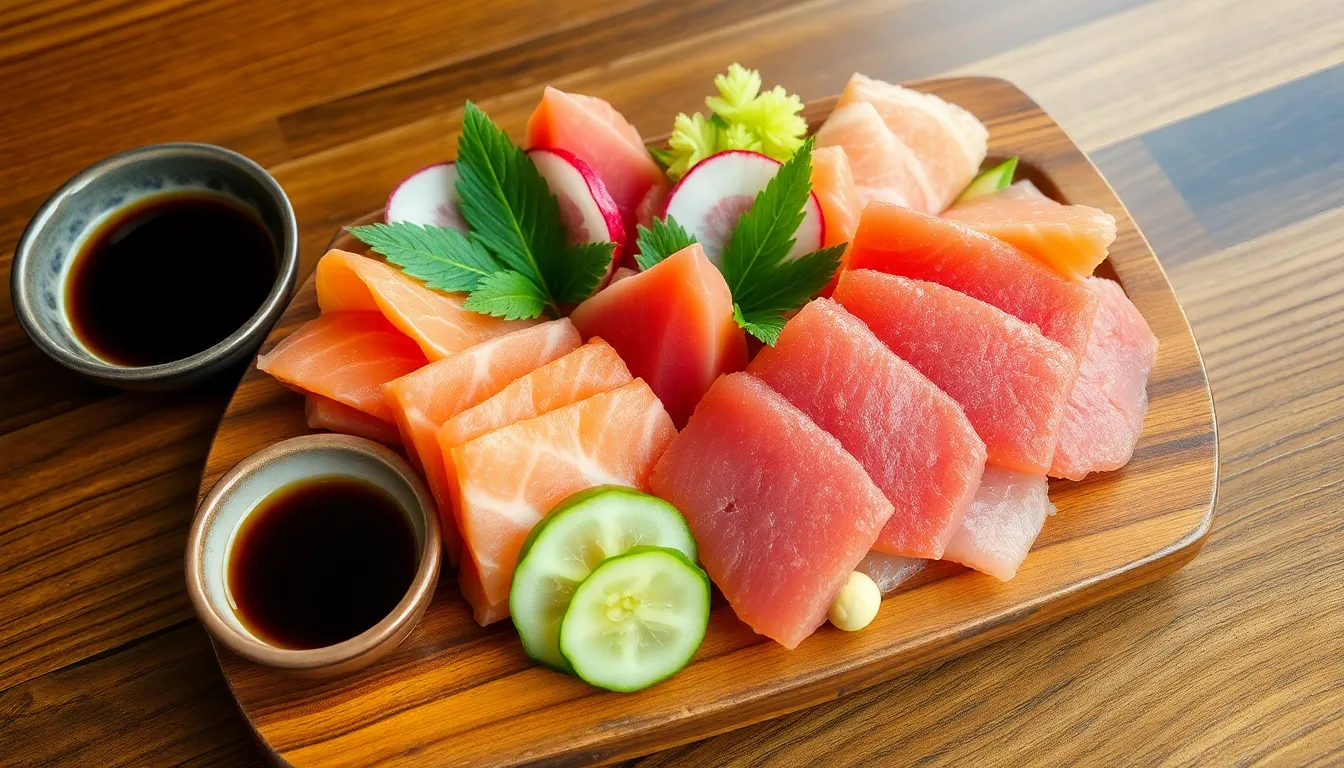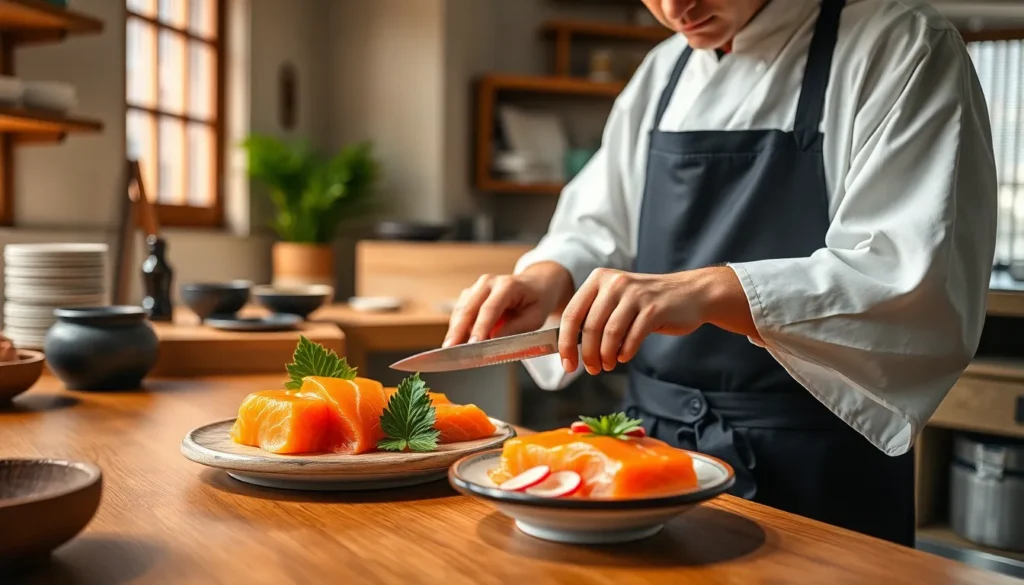Table of Contents
ToggleSashimi preparation isn’t just about slicing raw fish; it’s an art form that could make even Picasso jealous. Imagine the delicate dance of a sharp knife gliding through fresh fish, transforming it into bite-sized masterpieces that tantalize the taste buds. If you think sushi is the only star of the Japanese culinary scene, think again. Sashimi deserves its moment in the spotlight, and with the right techniques, anyone can impress their friends—or at least their taste buds!
Understanding Sashimi Preparation
Sashimi preparation involves meticulous techniques that enhance both flavor and presentation. First, the choice of fish plays a crucial role; fresh, high-quality ingredients yield the best results. Common types of fish used include salmon, tuna, and yellowtail, each requiring specific handling methods.
Knife skills stand as the backbone of sashimi preparation. Chefs utilize exceptionally sharp knives, such as yanagiba or usuba, for precise cuts. They typically slice the fish against the grain to ensure tenderness and a seamless texture.
Cleanliness remains essential throughout the process. Working on a sanitized cutting board prevents cross-contamination and maintains the integrity of the fish. Some chefs even chill the fish before slicing, improving its firmness and ensuring easier cuts.
Presentation amplifies the appeal of sashimi. Decorative garnishes, such as shiso leaves or daikon radish, complement the dish visually and in taste. Arranging sashimi artfully on a plate can elevate the dining experience.
Plating techniques vary, with some chefs opting for a minimalist approach while others embrace intricate designs. Attention to color contrasts enhances visual interest; vibrant fish against neutral backgrounds draws attention.
Sashimi often accompanies dipping sauces like soy sauce or wasabi, which add flavor depth. Understanding the balance of flavors contributes to an exceptional sashimi experience.
Each step in sashimi preparation reflects a commitment to culinary excellence. Mastery of these techniques distinguishes true artisans in the realm of Japanese cuisine.
Essential Ingredients for Sashimi

Sashimi requires specific ingredients to achieve its delicate flavors and presentation. Quality and freshness play vital roles in selecting fish and accompaniments.
Types of Fish for Sashimi
Salmon stands out as a popular choice due to its rich flavor and appealing texture. Tuna, particularly bluefin, is famed for its buttery taste and vibrant color. Yellowtail, with its slightly sweet profile, is another commonly enjoyed option. Mackerel offers a stronger flavor, valued for its oil content. Each fish variety enhances the sashimi experience through distinct tastes and textures. Choosing fish that is sashimi-grade, meaning it meets high freshness standards, is essential.
Other Ingredients and Accompaniments
Garnishes like shiso leaves, thinly sliced radishes, or cucumber add visual appeal and contrasting flavors. Soy sauce serves as a traditional dipping accompaniment, enriching the overall taste. Wasabi, often enjoyed with sashimi, provides a spicy kick, balancing the fish’s richness. Pickled ginger cleanses the palate between bites, enhancing the tasting experience. Other accompaniments, such as ponzu sauce or yuzu, introduce citrusy notes to complement the fish. Together, these ingredients elevate sashimi into an art form.
Tools Required for Sashimi Preparation
Sashimi preparation requires specific tools to ensure quality and precision. Using the right equipment enhances both the technique and presentation of this culinary art.
Knives and Cutting Tools
Quality knives are essential for perfect sashimi. A yanagiba knife, designed for slicing raw fish, is ideal for achieving clean cuts. It allows for seamless action, preserving the fish’s texture. Moreover, a deba knife can be useful for filleting fish. Knife maintenance, including regular honing and sharpening, plays a crucial role in cutting performance. Cutting boards made of bamboo or polypropylene help maintain the knife’s edge and ensure hygiene. These tools minimize damage to delicate fish flesh, resulting in beautifully presented sashimi.
Serving Plates and Accessories
Proper serving plates elevate the sashimi experience. Traditional ceramic or lacquered wooden plates enhance the presentation of sashimi. Presentation enhancements come from garnishes like shiso leaves, thinly sliced radishes, and colorful edible flowers. Accompanying accessories, such as soy sauce dishes and small bowls for wasabi, contribute to a complete dining experience. Additionally, using chopsticks made of wood or bamboo provides an authentic touch. Each element works together, creating an inviting atmosphere that complements the artistry of sashimi preparation.
Step-by-Step Guide to Sashimi Preparation
Sashimi preparation demands attention to detail and a commitment to quality. Each step plays a crucial role in achieving a delightful final dish.
Selecting Fresh Fish
Fresh fish selection determines the overall quality of sashimi. Look for fish labeled as sashimi-grade; this indicates high freshness standards. Common choices include salmon for richness, bluefin tuna for its buttery texture, and yellowtail for sweetness. Mackerel offers a stronger flavor that some might prefer. Assess the color and texture; vibrant hues and firm flesh signal superior quality. Additionally, consider the source of the fish, as sustainable practices enhance flavor and environmental impact.
Cleaning and Preparing the Fish
Cleaning the fish requires precision and care. Begin by rinsing it under cold water to remove any surface impurities. Next, use a sharp knife to remove scales, bloodline, and any leftover bones. Ensure cleanliness to prevent cross-contamination, a vital step for food safety. Pat the fish dry with a clean cloth or paper towel to prepare for slicing. Some chefs chill the fish briefly, firming the flesh for easier cuts. Handling the fish gently preserves its delicate texture and flavor, contributing to an exceptional sashimi experience.
Cutting Techniques
Cutting techniques significantly influence the texture and visual presentation of sashimi. Use a yanagiba knife, known for its sharpness and length. Begin slicing against the grain to ensure tenderness in each piece. Aim for uniform thickness, typically between a quarter and a half inch. Angling the knife slightly creates a more elegant presentation. Practice smooth, single strokes to avoid tearing the flesh, resulting in cleaner slices. Consistency in cuts enhances both the aesthetic appeal and mouthfeel of the sashimi.
Presentation Tips for Sashimi
Artful presentation enhances sashimi’s appeal. Start by choosing a clean, flat plate, as this provides a beautiful canvas. Arrange the sashimi slices in a fanned-out pattern, showcasing their colorful edges. Each piece should reflect the freshness and quality of the fish.
Garnishes play a vital role. Use shiso leaves as a bed for the sashimi, adding a pop of green to contrast with the fish’s natural hues. Thinly sliced radishes can add visual interest and a crunchy texture, while edible flowers introduce an elegant touch.
Dipping sauces add depth to the overall experience. Soy sauce should be served in a small, traditional dish at one side of the plate, allowing for easy access. A small dollop of wasabi can sit nearby, offering an optional kick of flavor. Always provide pickled ginger, not just for palate cleansing but also for its vibrant color.
Lighting can significantly impact presentation. Soft, natural lighting highlights the glistening surfaces of the fish. Avoid harsh overhead lights, which may distort the colors and textures.
Serve with traditional Japanese utensils. Wooden chopsticks enhance the authenticity of the dining experience. When thoughtfully arranged, each detail contributes to the overall enjoyment of savoring sashimi.
Fortifying the experience with attention to visual elements helps elevate sashimi from a simple dish to a culinary masterpiece. Each component, from the fish’s arrangement to the choice of garnishes, plays a critical role in presenting a dish that resonates with flavors and artistry.
Sashimi preparation is a refined art that showcases the beauty and skill of Japanese cuisine. With a focus on high-quality ingredients and meticulous techniques, anyone can create impressive dishes that delight the senses. The harmony of flavor and presentation transforms simple raw fish into a culinary experience that deserves appreciation.
By mastering the essential knife skills and understanding the importance of freshness, individuals can elevate their sashimi-making abilities. Each carefully crafted piece not only highlights the fish’s natural qualities but also reflects the dedication and passion of the chef. Embracing this craft opens the door to endless culinary possibilities while honoring the rich traditions of sashimi.








